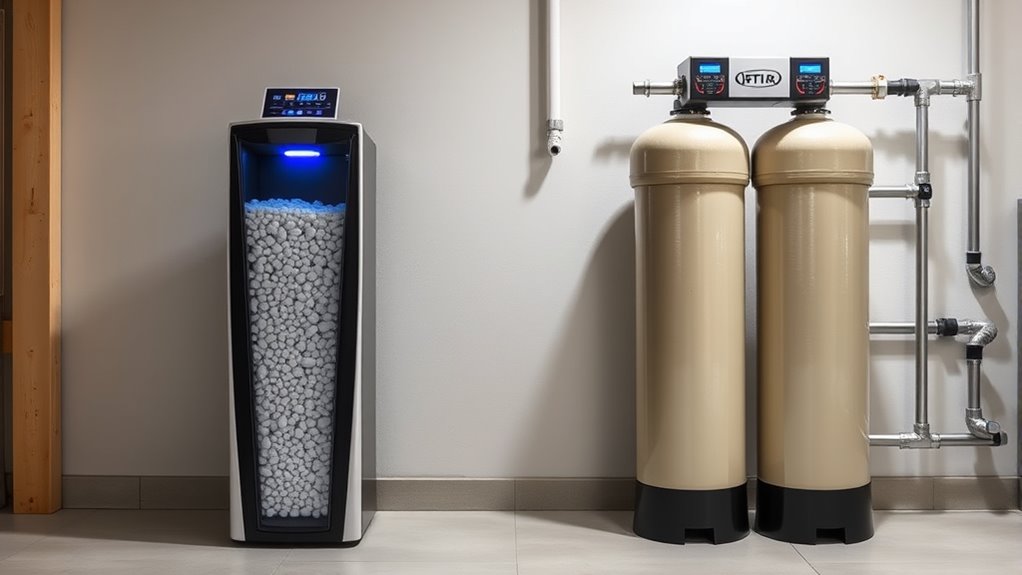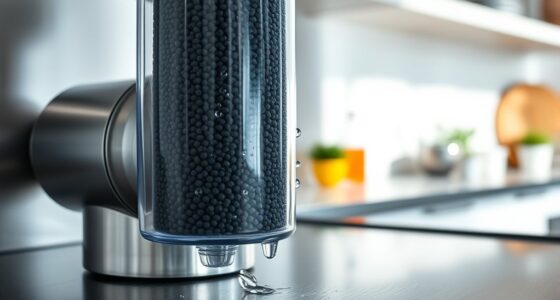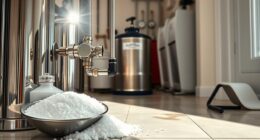When choosing between a single tank and dual tank water softener, consider your household size, water usage, and budget. A single tank is cost-effective, ideal for smaller households with moderate needs, but it can run out of softened water during peak demand. A dual tank provides continuous soft water, perfect for larger families or high water hardness, but it’s more expensive upfront. Exploring more details will help you make the best choice for your home’s needs.
Key Takeaways
- Single tank softeners are cost-effective and suitable for small households with moderate water demand.
- Dual tank systems provide continuous soft water, ideal for large families or high water hardness areas.
- Consider space availability, as dual tanks require more room and complex plumbing compared to single tanks.
- Dual tanks generally have higher initial costs but offer better salt efficiency and long-term savings.
- Match your household size and water needs to choose a system that balances budget, convenience, and ongoing operational costs.

When selecting a water softener, understanding the different types available can help you make an informed decision that best suits your needs. The two main options—single tank and dual tank softeners—each have distinct advantages and considerations, particularly around salt efficiency and installation costs. Knowing how these factors impact your long-term expenses and daily operation will guide you toward the right choice.
A single tank softener is typically more compact and involves a simpler setup, making it a popular choice for households with moderate water usage. These units use one resin tank that cycles between softening and regeneration, which means the system needs to be smaller and easier to install. Salt efficiency is a key benefit here; since the system regenerates less frequently and only as needed, you’ll often use less salt over time, reducing ongoing operational costs. However, if your household has high water demand, a single tank can run out of softened water during regeneration, leading to temporary inconvenience.
Single tank softeners are compact, cost-effective, and ideal for moderate water usage but may face shortages during high demand.
In contrast, dual tank softeners employ two resin tanks, allowing one to operate while the other regenerates. This setup ensures a continuous supply of soft water, making it ideal for larger households or those with high water hardness levels. Although dual tank systems are generally more expensive upfront, the installation costs can be higher because they require more space and more complex plumbing. But on the upside, these units tend to be more salt-efficient in the long run because they can regenerate more frequently and in smaller amounts, optimizing salt use and reducing waste. If you prioritize minimal disruptions and consistent soft water, the higher initial investment and installation costs may be justified by ongoing savings and convenience.
When comparing these options, consider your household size and water usage patterns. If you have a smaller household or are on a tight budget, a single tank system offers a cost-effective, straightforward solution, especially with its lower installation costs and good salt efficiency. However, if you have a large family or high water hardness, a dual tank system might be worth the extra upfront investment due to its ability to provide continuous soft water and better long-term salt efficiency. Additionally, understanding the benefits of decluttering can help you better organize your space to accommodate larger systems and maintain your water softening units more easily. Ultimately, understanding how each system’s features align with your needs will help you make a choice that balances initial costs with ongoing operational expenses, ensuring you get the best value and performance from your water softener.
Frequently Asked Questions
Can Dual Tank Softeners Handle Higher Water Demands Than Single Tanks?
Yes, dual tank softeners handle higher water demands better than single tanks. They provide a greater water flow capacity, ensuring your system can meet peak usage without interruption. With their larger system size and simultaneous regeneration capability, dual tanks offer continuous soft water, making them ideal for larger households or high-demand situations. You’ll experience fewer delays and more reliable performance, especially during peak times.
Which Softener Type Requires More Maintenance Over Time?
You’ll find that dual tank softeners require more maintenance over time, mainly due to increased maintenance frequency and higher repair costs. With two tanks to monitor, refill, and occasionally repair, you spend more time and money keeping them in top shape. Conversely, single tank systems are simpler, leading to less frequent maintenance and lower repair costs, making them a more straightforward choice if you want to minimize ongoing upkeep.
Are Dual Tank Systems More Energy-Efficient Than Single Tank Systems?
Yes, dual tank systems are generally more energy-efficient than single tank systems. They use less energy because one tank always remains on standby, reducing the need for frequent regeneration cycles. This improved energy consumption translates to better cost efficiency over time. You’ll save on electricity bills and enjoy continuous softened water, making dual tank systems a smart choice if you prioritize energy savings and long-term savings.
How Does Water Hardness Level Influence the Choice Between Single and Dual Tanks?
If your water hardness is high, you’ll want a dual tank system because it offers greater softener capacity and continuous operation. For moderate or low hardness levels, a single tank may suffice, as it handles softer water efficiently. Consider your water hardness to determine the softener capacity needed; higher hardness demands more capacity, making dual tanks a better choice for uninterrupted softening.
What Is the Typical Lifespan Difference Between Single and Dual Tank Softeners?
Your softener’s lifespan is like an epic saga—dual tank systems often last 20-25 years, outlasting single tanks by a decade. They may have higher installation costs but save on salt usage during continuous operation, reducing maintenance. Single tanks typically last around 10-15 years and are less expensive upfront, but they might need replacement sooner. Choose based on your water needs, budget, and long-term durability.
Conclusion
So, whether you pick a single or dual tank, remember: the real decision is whether you’re brave enough to trust your softener or just want to keep guessing. After all, who needs consistent water quality when you can enjoy the thrill of sudden hard water surprises? Choose wisely, or don’t—either way, your pipes will keep reminding you who’s boss. Because in the end, it’s not about the best option; it’s about surviving the water chaos. Cheers to softening your life!









